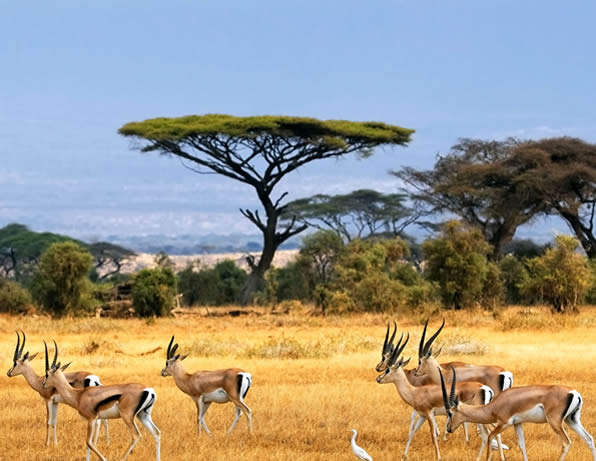 |
| Savanna grassland |
Savannas are areas of continuous grass or sedge cover beneath trees that range from scattered, twisted, and gnarled individuals to open wood lands. Deciduous tropical forests have continuous to open forest cover and undergo a leafless period during a seasonally lengthy dry season.
Where the annual rainfall in tropical regions is less than 2,000 millimeters and three to six months out of the year are dry, savannas and deciduous forests are common. Both savannas and deciduous tropic forests often occur where the annual rainfall is less than that of savannas. Together, the two biomes are referred to here as the dry tropical biome.
A pronounced pattern of seasonally wet and dry periods is the most important factor affecting the distribution of these types of plant cover. Higher soil fertility favors forest over grasses and savanna such as in the cerrado of Brazil, which occurs only on certain geological formations and low-nutrient soils.
  |
Fire has been a dominant feature of these biomes, and human influences—fires, agriculture, and grazing of animals—have interacted with climate to produce a varied landscape.
The dry tropical biome is most geographically widespread on the continents of Africa, South America, and Australia, with smaller enclaves in Asia. The world’s largest expanses of dry forest—the Brachystegia woodland across Central Africa, the cerrado (savanna) and caatinga (dry forest) of the Amazon basin, and much of interior Australia—are notable examples.
“Elephant grass savanna,” with tall grasses up to 4 meters tall and scattered trees, occurs exclusively in Africa. In the West Indies, dry forest occurs in rain-shadow zones on the leeward sides of islands affected by the trade winds.
Plant Adaptations and Diversity of Life-Forms
As the rainfall decreases below 2,000 millimeters, and especially below 1,000 millimeters, the height of the forest decreases and the proportion of trees that are deciduous increases. In the dry tropics, leaf fall occurs in response to drought, and therefore the lengthy dry season becomes a selective pressure to which plants have adapted.
Tree leaves tend to be compound, with small leaflets that help plants exchange heat with their surroundings better than large, simple leaves; rates of leaf respiration and transpiration are thereby reduced. Sclerophyllous leaves are common, aiding in moisture retention, and the drier,more open wood lands may have cacti or other succulents.
 |
| Deciduous Tropical Forest |
The dry forest is far less species-rich than the rain forest, but the diversity of life-forms and the proportion of endemics are greater.
For example, dry forests may contain xerophytic (dry-adapted) evergreens, either obligatively or facultatively deciduous trees, trees with photosynthetic bark, plants that use the crassulacean acid metabolism (CAM) photosynthesis as well as C3 and C4 dicots, grasses, bromeliads, lianas, epiphytes, and hemi parasites. Trees from Fabaceae (the legume family) are the most well-represented family among trees.
Dry forests contain a higher proportion of wind dispersed species than wetter forests, and many trees will have their flowering and fruiting controlled by the duration and intensity of the dry season.
Synchronous flowering within and among species is common, and many produce seed during the dry season. Flowers are often conspicuous and visited by specialized pollinators such as hawk-moths, bats, and bees.
It is incorrect to generalize about savannas and dry tropical forests because, although they both occur in the drier tropics, the two vegetation types occur in different habitats and are adapted differently to their respective environments.
Trees of the cerrado in northeast Brazil are deeply rooted, tap groundwater, and have high rates of transpiration. Drought here is atmospheric, as water is always available below 2 meters of soil depth.
The deciduous caatinga of central Brazil, however, receives only 500 millimeters of rain yearly, and transpiration of trees is low. Here, trees suffer significant water deficits during the long, dry season, are truly xerophytic, and exhibit classic adaptations to drought.
Trees of the cerrado have a number of adaptations that confer resistance to fire. These include a thick, corky bark, the ability to form adventitious roots from buds on roots following the burning of the stem, and the cryptophyte or hemicryptophyte life-form (cryptophytes produce buds underground). Many herbaceous species are induced to flower by fire.
   |
Human Impacts and Conservation
Fires have occurred in the Brazilian cerrado for thousands of years based on carbon 14 dating of charcoal fragments. Fire is thus an environmental factor to which the vegetation has become adapted.
Yet, the human influence has been to increase the incidence of fire. The cerrado has changed as a result to a more open form of plant cover with fewer trees and shrubs. In addition, timber extraction, charcoal production, and ranching have altered the savanna landscape.
The ability of below ground organs to survive such types of disturbance has increased the ability of the cerrado to persist. Yet it is estimated that 50 percent of the cerrado has been destroyed,much of this the result of clearing for agriculture since the 1960’s.
Because of better soils and fewer pests, humans in tropical areas of Central America have mostly chosen the dry and moist life zones as places to live rather than the wetter rain-forest zones.
As a result, dry forest ecosystems have been subject to massive disturbance. Today, only a small fraction of the original dry forest remains. Fire has been used as a means of clearing the forest for farming, but, unlike the savanna, the dry forest is not adapted to fire.
 |
| Savanna with lions |
At Guanacaste, Costa Rica, a well-known tropical conservation project, restoration of dry forest, is dependent on controlling annual fires set by farmers and ranchers and supporting the return of forest vegetation to dry areas.
In Africa, large areas of dry forest are burned annually by farmers, and areas of dense, dry forest have been converted tomore open forest or even savanna. Sustainable land-use systems are urgently needed for dry tropical regions.